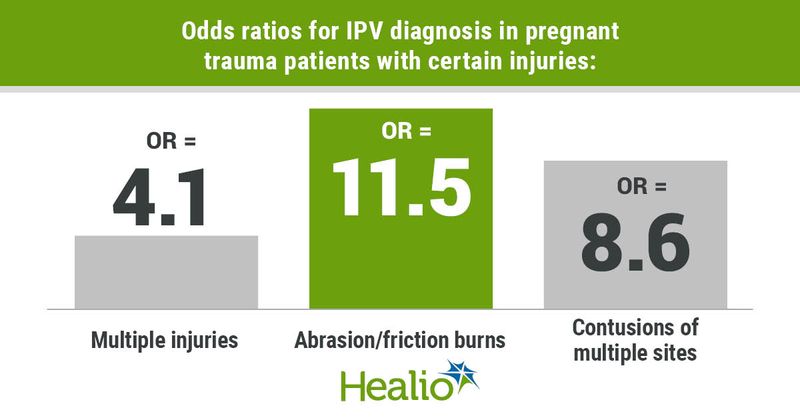Intimate partner violence screening needed in pregnant patients with certain injuries
Pregnant trauma patients admitted to EDs should be screened for intimate partner violence if they have certain injuries, according to data published in the Journal of the American College of Surgeons.
“To the best of my knowledge, there has not been an analysis to show specific risk factors for intimate partner violence in a defined population,” Paul T. Albini, MD, FACS, an acute care surgeon at Riverside University Health System in Moreno Valley, California, said in a press release. “We wanted to study intimate partner violence in pregnant patients as we know that they are particularly vulnerable, and their outcomes are generally poor.”

Albini and colleagues identified pregnant women aged 18 to 40 years with traumatic injuries who were listed in the Nationwide Emergency Department Sample from 2010 to 2014. The researchers compared patterns of injury in pregnant trauma patients with and without a diagnosis of intimate partner violence (IPV).
In total, there were 556 pregnant trauma patients who had an IPV diagnosis and 73,970 pregnant trauma patients without an IPV diagnosis.
Prevalence of injuries, outcomes
Among all patients, those who had an IPV diagnosis more commonly had multiple injury diagnoses compared with those who did not have an IPV diagnosis (64.6% vs. 26.7%; P < .001). They were also more likely to have diagnoses of suffocation (11% vs. 0.1%; P < .001), unspecified head injuries (8.9% vs. 3.3%; P < .01), face, scalp or neck contusions (12.8% vs. 4.2%; P < .001), contusion of multiple sites (6.1% vs. 0.9%; P < .001) and abrasion/friction burns (4% vs. 0.4%; P < .001).
Patients without an IPV diagnosis were more likely to be injured by falling (38.2% vs. fewer than 10 instances; P < .001), motor vehicle or traffic (32% vs. fewer than 10 instances; P < .001) and cutting or piercing (8.5% vs. fewer than 10 instances; P < .01) compared with pregnant trauma patients with an IPV diagnosis. They also more commonly had neck sprains (8.4% vs. 2.9%; P < .01).
Notably, mortality and hospital admissions among both groups of patients were rare.
Predictors of IPV
Analyses revealed that Medicaid insurance (OR = 2.3; 95% CI, 1.4-3.6) and self-paying for care (OR = 2.2; 95% CI, 1.2-3.9) predicted an IPV diagnosis in pregnant trauma patients. Other predictors of IPV diagnosis included multiple injuries (OR = 4.1; 95% CI, 2.8-6), head injuries (OR = 2.4; 95% CI, 1.2-4.7), face, neck or scalp contusions (OR = 2.7; 95% CI, 1.5-4.8), abrasion/friction burns (OR = 11.5; 95% CI, 4.4-29.5) and contusions of multiple sites (OR = 8.6; 95% CI, 3.7-20).
Injuries by cutting or piercing and falling were associated with lower odds of IPV diagnosis (OR = 0.1; 95% CI, 0.01-0.7; and OR = 0.01; 95% CI, 0.002-0.08, respectively).
“I think we have identified certain risk factors that should prompt screening for intimate partner violence,” Albini said in the release. “Using these risk factors to guide screening can happen anywhere, not just at our institution. I think that would be very helpful and may address an underlying problem for a proportion of patients.”

